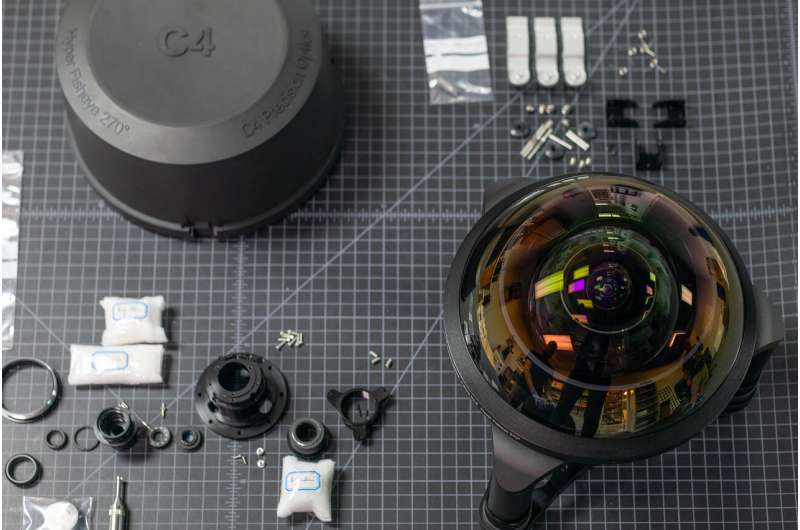Credit: Roger Cicala
The superstar of a fisheye lens emerged this month, shown in a video, where a team fashioned a custom fisheye lens that has a 270-degree field of view. Wow, as that was being dubbed as "insane" and "monster-like" but the descriptions were all conveyed with a wide-eyed measure of affection for Roger Cicala, founder of Lensrental.com.
He fashioned this prototype with the help of his small team. A fisheye lens is defined as a type of ultra-wide angle lens showing a distorted, spherical view of the world, evident in curved, outer corners of the photo. We referred to the Underwater Photography Guide.
The video "Assembling the Widest Fisheye Lens Ever" was posted earlier this month and he wrote a detailed blog about how it was put together, titled "Assembling the C-4 Optics 4.9mm f3.5 Hyperfisheye Prototype."
The video is a don't-blink assembly timelapse of the custom lens; the A-Z details in the blog include materials used, even including the syringe full of potting cement.
What's so special about this lens: For one, think massive. This is a 270-degree field of view, for immersive video and specialty shots.
Are there advantages in using something like this for virtual reality? Yes. Stan Horaczek in Popular Science noted that the usual way takes an array of cameras that simultaneously capture footage in different directions while software stitches it all together.
"The circular fisheye means the image will appear in the center of the frame as a circle with black corners. Software can unpack the images into a view that VR headsets like the Oculus Rift can understand," said Popular Science.
Cicala explained that "the lens sees behind itself. An ultra-wide 15mm fisheye lens gives a 180-degree field of view while an 11mm rectilinear lens is less than 120 degrees."
Horaczek in Popular Science said the fisheye lens creates "a circular image on a typical full-frame image sensor, which is the same size as a frame of 35mm film."
(Horaczek credits Cicala as "one of the world's foremost experts on lens testing." He said Cicala and designer Brian Caldwell started C-4 Precision Optics in 2015. )
"Compared to many of the lenses we've taken apart, this is all mechanical lens is rather simple: no focus motors, image stabilizers, etc. But even a simple lens is a very complex structure. This post will probably give you a good idea of how much mechanical design is required to make even a very basic lens."
Who would even use it, anyway? "Naturally you wouldn't want this for snapshots," said Devin Coldewey in TechCrunch.. "It would be for very specific shots in high resolution that you would massage to get back to something resembling an ordinary field of view, or somehow incorporate into a VR or AR experience."
The weather service? Hanging from rafters of sports games to show during critical game moments? Those ideas were mentioned according to the article in Popular Mechanics.
Loz Blaine in New Atlas offered readers an interesting set of use cases that he could imagine. Blaine recognized the cases would be limited (As for price, Blaine reckoned "a pretty penny" and Zhang in PetaPixel said that "Just the first element in the lens alone costs about $5,000") but here goes.
"This thing could capture the entirety of the night sky, for example, and with such a wide angle, you could use longer exposures than usual without the stars starting to smudge and create trails. And it'll do some super cool things for architectural shots and interiors."
Several tech-watching sites said that as far as they knew this was the widest angle fisheye lens in existence.
Horaczek in Popular Science remarked that lens development can be quite trivial, as "you can punch a pinhole in an old oatmeal canister, add some film on the other side, and start making pictures." Unless glass gets involved. Different story. Then "camera lenses can achieve some truly amazing feats of refraction." This chunk of optics, as he phrased it, was an example.
Cicala said the lens was one of two developed for C-4 Optics, "so it likely won't ever show up on our rental list."
More information: www.lensrentals.com/blog/2019/ … erfisheye-prototype/
© 2019 Science X Network
























